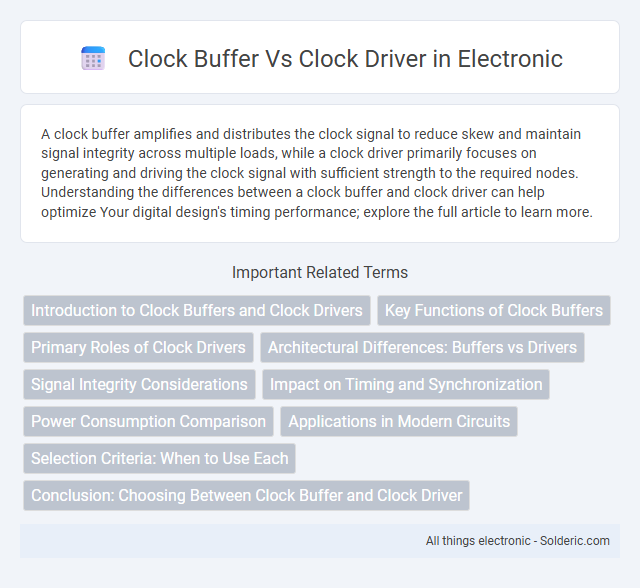A clock buffer amplifies and distributes the clock signal to reduce skew and maintain signal integrity across multiple loads, while a clock driver primarily focuses on generating and driving the clock signal with sufficient strength to the required nodes. Understanding the differences between a clock buffer and clock driver can help optimize Your digital design's timing performance; explore the full article to learn more.
Comparison Table
| Aspect | Clock Buffer | Clock Driver |
|---|---|---|
| Primary Function | Amplifies clock signals without distortion | Distributes clock signals to multiple loads |
| Signal Integrity | Maintains signal waveform and timing | Manages load-driven signal degradation |
| Load Driving Capability | Low to moderate load drive | High load drive capacity |
| Typical Usage | Signal conditioning within circuits | Clock distribution networks |
| Power Consumption | Lower power consumption | Higher power consumption due to driving multiple loads |
| Delay Impact | Minimal added delay | May introduce additional delay based on load |
Introduction to Clock Buffers and Clock Drivers
Clock buffers and clock drivers are essential components in digital circuit design, responsible for distributing clock signals efficiently across integrated circuits. Clock buffers primarily maintain signal integrity and reduce skew by amplifying or reshaping the clock signal without altering its timing, ensuring synchronized operation of sequential elements. Clock drivers, on the other hand, actively drive clock signals to multiple loads or domains, providing the necessary power and impedance matching to maintain timing accuracy in complex clock distribution networks.
Key Functions of Clock Buffers
Clock buffers ensure signal integrity by amplifying and stabilizing clock signals across multiple circuit components, preventing signal degradation and timing errors. They distribute the clock signal evenly to various parts of your system, maintaining synchronization and reducing skew. These key functions of clock buffers are crucial for enhancing overall performance and reliability in digital circuits.
Primary Roles of Clock Drivers
Clock drivers primarily generate and amplify clock signals to ensure stable and synchronized timing across digital circuits, optimizing signal integrity and propagation delay. Clock buffers focus on distributing the clock signal evenly while minimizing skew and loading effects throughout the circuit. Your system's performance and timing accuracy heavily rely on the effective functioning of clock drivers in managing signal strength and timing precision.
Architectural Differences: Buffers vs Drivers
Clock buffers and clock drivers differ primarily in their architectural roles and design complexity within timing distribution networks. Clock buffers amplify the clock signal to maintain signal integrity and reduce skew across the circuit without significantly altering waveform characteristics, often composed of simple inverter chains or buffer stages. Clock drivers, however, are designed with additional circuitry for increased drive strength and impedance matching to manage larger fanout loads and minimize clock skew, typically incorporating complex transistor-level designs and feedback mechanisms.
Signal Integrity Considerations
Clock buffers and clock drivers both play crucial roles in managing timing signals in digital circuits, but signal integrity considerations differ significantly between them. Clock buffers primarily focus on maintaining signal amplitude and reducing distortion to ensure clean transitions, minimizing rise and fall time variations to prevent jitter. Clock drivers, on the other hand, handle higher capacitive loads and require careful impedance matching and slew rate control to reduce reflections, ringing, and crosstalk that can degrade signal integrity in high-speed clock distribution networks.
Impact on Timing and Synchronization
Clock buffers improve timing accuracy by reducing clock skew and jitter, ensuring synchronized signal distribution across multiple circuit components. Clock drivers enhance signal integrity and drive capability, supporting larger load capacitances without degrading signal quality or timing margins. Both components are critical in optimizing timing paths and maintaining synchronization in high-speed digital designs.
Power Consumption Comparison
Clock buffers typically consume less power compared to clock drivers due to their simpler internal circuitry and lower output drive strength, making them suitable for distributing clock signals with minimal load. Clock drivers are designed to drive higher capacitive loads, which results in increased dynamic power consumption as they switch larger amounts of current. Selecting between a clock buffer and a clock driver requires balancing power efficiency with the necessary drive capability for the target clock distribution network.
Applications in Modern Circuits
Clock buffers and clock drivers play crucial roles in modern circuits by ensuring signal integrity and timing accuracy across complex digital systems. Clock buffers amplify and distribute clock signals with minimal delay and jitter, making them ideal for large-scale integrated circuits such as CPUs and FPGAs. Your choice between these components depends on the required load driving capability and the need to minimize clock skew in synchronous designs.
Selection Criteria: When to Use Each
Clock drivers are ideal for driving large capacitive loads in clock distribution networks, ensuring signal integrity and minimizing skew across multiple branches. Clock buffers suit applications requiring signal strengthening and isolation without significant delay overhead, making them preferable for moderate load conditions or local clock signal replication. Selection depends on load capacitance, required drive strength, and delay budget; clock drivers are chosen for high fan-out and critical timing paths, while clock buffers fit simpler, low-latency buffering needs.
Conclusion: Choosing Between Clock Buffer and Clock Driver
Clock buffers are designed to distribute clock signals with minimal delay and low skew, making them ideal for maintaining signal integrity across multiple loads. Clock drivers provide higher drive strength and often include features like adjustable delay and edge rate control, suitable for complex clock distribution networks requiring robust signal driving capabilities. Your choice depends on whether you prioritize signal fidelity and low skew (clock buffers) or stronger drive capability and flexibility (clock drivers) for your specific timing requirements.
Clock buffer vs clock driver Infographic

 solderic.com
solderic.com